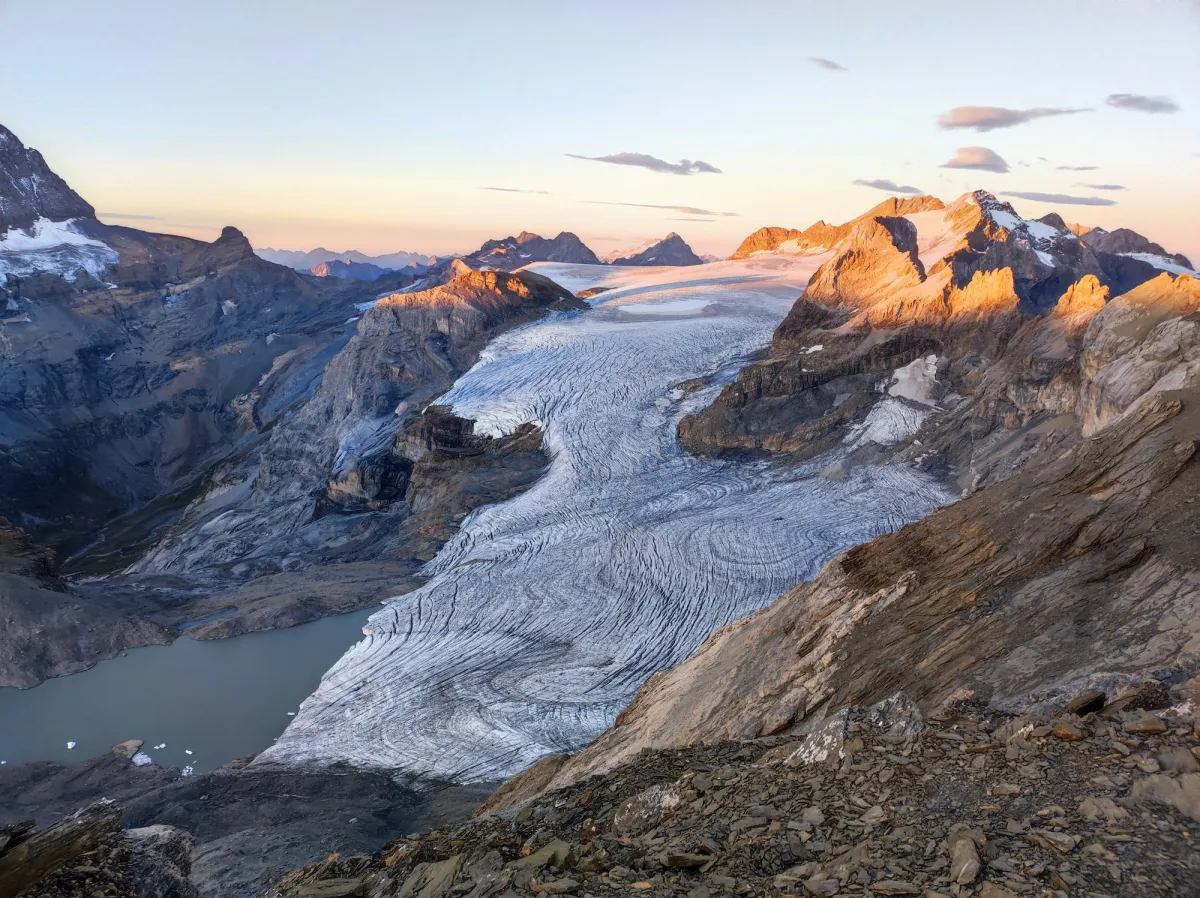
Alpine Glaciers Are Melting Even On The Highest Peaks
I cover climate change and energy through reportages, articles, interviews and in-depth reports. I am interested in the impacts of global warming on everyday life and solutions for an emission-free planet. Passionate about travel and discovery, I studied biology and other natural sciences. I have been a journalist for SWI swissinfo for more than 20 years.
-
More from this auth
Italian Departme
-
Deutsch
de
Die Alpengletscher schmelzen auch an den höchsten Gipfeln
Read more: Die Alpengletscher schmelzen auch an den höchsten Gipfel
Français
fr
Les glaciers des Alpes fondent même sur les sommets les plus élevés
Read more: Les glaciers des Alpes fondent même sur les sommets les plus élevé
Italiano
it
I ghiacciai delle Alpi si sciolgono anche sulle vette più alte
Original
Read more: I ghiacciai delle Alpi si sciolgono anche sulle vette più alt
Climate change is giving Swiss glaciers no respite. In 2025 their volume shrank by 3% compared to the previous year, according to the latest assessment by the Swiss Glacier Monitoring Network (GLAMOS) and the Swiss Academy of Natural Sciences. This is the largest retreat after those in 2003, 2022 and 2023.
“This year turned out to be a little less extreme than we feared,” Matthias Huss, director of GLAMOS, tells Swissinfo.“However, what strikes me and worries me is that we're getting used to these very negative years. It's a new normal, but one that shouldn't be there.”
The Alps are warming faster than the global average and Swiss glaciers have lost a quarter of their volume since 2015, GLAMOS points out. Between 2016 and 2022, 100 glaciers – out of a total of about 1,400 – disappeared completely in Switzerland.
External Content Temperatures above 0°C even at an altitude of 5,000 metresThe melting this year was helped by the scarcity of snow during last winter. The snow layer that usually protects the glaciers from the summer heat was insufficient. In some regions of Graubünden in eastern Switzerland, fresh snow levels were among the lowest ever observed, GLAMOS says.
Heatwaves in June – the second-warmest since measurements began in 1864 – and August also contributed to glacier shrinkage.“In June, I was on the same glacier several times: it's incredible to observe that the thickness can shrink by a metre in just over a week,” Huss says.
The glaciers most affected are those below an altitude of 3,000 metres. The thickness of the Plaine Morte glaciers in the Bernese Alps and the Silvretta glacier in Graubünden has decreased by over two metres since 2024. The melting of the ice on the Aletsch, the largest glacier in the Alps, has exceeded four metres in some areas.
However, not even the highest glaciers are spared. This summer, the zero degree line has exceeded 5,000 metres several times.“This is a new phenomenon, which we have observed only in recent years. The melting of the glaciers also affects the highest peaks,” Huss says, adding that only a relatively cool and wet July made it possible to“avoid the worst”.
Evolution of the length of the Rhone Glacier in Switzerland between 2008 and 2025. Matthias Huss Glaciers retreat in all Alpine countries
Glacier retreat is not limited to Switzerland.“All glaciers in the Alps share the same fate: a frontal retreat and a reduction in area and thickness, even on the north-facing slopes,” Vanda Bonardo, head of the Glacier CaravanExternal link , tells Swissinfo.
The aim of this travelling campaign, which originated in Italy, is to monitor Alpine glaciers and raise awareness of the impacts of climate change. The Caravan visited eight glaciers in Italy, Switzerland and Germany this summer.
The evolution of the Adamello glacier in Lombardy, Italy's largest, is particularly significant, according to Bonardo.“Compared to the visit two years ago, it has completely changed: the front has broken and the length has decreased by several hundred metres”.
Over the past 60 years, the Italian Alps have lost an area of ice of more than 170km2, equal to the surface area of Lake Como, says the Glacier Caravan in its latest report.
Due to global warming, the fate of the 93 glaciers in Austria also appears sealed.“In 40 to 45 years, the whole of Austria will be practically ice-free,” said Andreas Kellerer-Pirklbauer, head of the National Glacier Survey, last year.
The Mer de Glace, the largest glacier in France, located above Chamonix, has been retreating by an average of 30 metres a year since 2003. If global temperatures continue to rise according to current trajectories, the glacier volume will shrink by 80% by 2100, predicts the Université Grenoble Alpes.
In Germany, the greatest concern is for permafrost, the permanently frozen layer of ground. It could disappear completely within 50 years, increasing the instability of mountain slopes.
More Climate solutions Why melting glaciers affect us allAlpine glaciers could disappear by the end of the century. The consequences will be felt not only in the Swiss Alps but all over the planet.
Read more: Why melting glaciers affect us al
Legal Disclaimer:
MENAFN provides the
information “as is” without warranty of any kind. We do not accept
any responsibility or liability for the accuracy, content, images,
videos, licenses, completeness, legality, or reliability of the information
contained in this article. If you have any complaints or copyright
issues related to this article, kindly contact the provider above.


















Comments
No comment